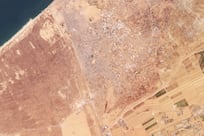Non-performing loans in the banking system rose for the eighth month in a row in April as Central Bank officials forecast a further increase in bad debt in the second half of the year.`
Exposure to an oversupply of units in the property market was a main reason for the rise in non-performing loans (NPLs), said Saeed al Hamiz, the senior executive director of banking supervision and examination at the Central Bank.
"Usually when you have a global financial crisis it's natural for [NPLs] to go up as the ability for people to pay is affected," he said yesterday.
"Demand for business and demand for real estate went up and now there's a lot of supply."
NPLs had risen by 6.67 per cent at the end of April, up from 6.25 per cent at the end of December, Mr al Hamiz said on the sidelines of an Islamic finance workshop at the Central Bank. He said he expected NPLs to rise "slightly" in the remainder of the year.
The need for lenders to build safeguards against further souring loans has been blamed in part for a sluggish recovery in credit growth.
Banks increased lending to the property market before the global financial crisis as prices soared. But a subsequent collapse in prices by more than half from their peaks in some areas has exposed banks to heavy losses.
In addition, lenders have taken a hit from their exposure to debt rescheduling of some companies. Dubai World signed a final US$24.9 billion (Dh91.46bn) debt restructuring agreement with creditors in March. Banks have also felt the pain of defaults on financial obligations by two Saudi conglomerates, the Saad Group and Ahmad Hamad Al Gosaibi and Brothers, in 2009.
"We have not yet reached a stage where we have to stop taking provisions," said Tirad Mahmoud, the chief executive of Abu Dhabi Islamic Bank.
"Islamic banks and conventional banks both have one common issue and that is the high level of non-performing risk assets and the high level of credit provisions that continue to happen.".
Total NPL provisions by banks rose almost 36 per cent to Dh44.3bn last year compared with Dh32.6bn in 2009, according to Central Bank data. They grew to Dh46.6bn in March, the latest data show.
The reluctance of some banks to recognise early the possibility of losses on some high-profile exposures meant impairment figures were likely to be understated for some banks, according to a recent Standard & Poor's GCC banking report.
"The amount of reported restructured loans is especially significant in the UAE and if we add this figure to reported NPLs, the ratio reaches into the double-digits for the country's banking system," said the report, released on Tuesday.
The asset quality of some UAE banks compares unfavourably with banks in the rest of the GCC, it said.
To tighten regulations, the Central Bank last year required lenders to classify bad loans as being in default - and make provisions accordingly - after 90 days instead of the previous 180 days. It also last month tightened retail lending caps to safeguard banks and customers against the risk of future defaults.





